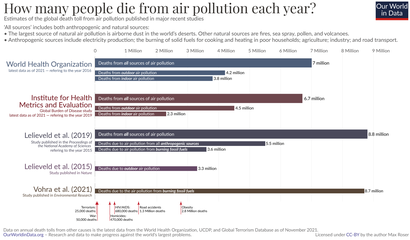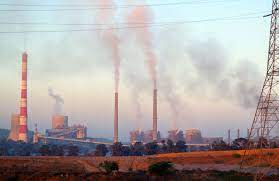Health effects
Even at levels lower than those considered safe by United States regulators, exposure to three components of air pollution, fine particulate matter, nitrogen dioxide and ozone, correlates with cardiac and respiratory illness. In 2020, pollution (including air pollution) was a contributing factor to one in eight deaths in Europe, and was a significant risk factor for pollution-related diseases including heart disease, stroke and lung cancer. The health effects caused by air pollution may include difficulty in breathing, wheezing, coughing, asthma and worsening of existing respiratory and cardiac conditions. These effects can result in increased medication use, increased doctor or emergency department visits, more hospital admissions and premature death. The human health effects of poor air quality are far reaching, but principally affect the body’s respiratory system and the cardiovascular system. Individual reactions to air pollutants depend on the type of pollutant a person is exposed to, the degree of exposure, and the individual’s health status and genetics. The most common sources of air pollution include particulates, ozone, nitrogen dioxide, and sulfur dioxide. Children aged less than five years who live in developing countries are the most vulnerable population in terms of total deaths attributable to indoor and outdoor air pollution. Under the Clean Air Act (CAA), U.S. EPA sets limits on certain air pollutants, including setting limits on how much can be in the air anywhere in the United States. New research demonstrates that the biological and health outcomes of mixed exposures (Example PM + Ozone) could be significantly greater than individual exposures.
Mortality

Share of deaths from outdoor air pollution, OWID
The World Health Organization estimated in 2014 that every year air pollution causes the premature death of some 7 million people worldwide.Studies published in March 2019 indicated that the number may be around 8.8 million. A 2022 review concluded that air pollution was responsible for 6.67 (5.90–7.49) million premature deaths in 2019. It concluded that since 2015 little real progress against (superordinate) pollution, which remained at ~9 million earlier deaths, can be identified. Causes of deaths include strokes, heart disease, COPD, lung cancer, and lung infections.
Urban outdoor air pollution is estimated to cause 1.3 million deaths worldwide per year.Children are particularly at risk due to the immaturity of their respiratory organ systems.In 2015, outdoor air pollution, mostly by PM2.5, was estimated to lead to 3.3 (95% CI 1.61–4.81) million premature deaths per year worldwide, predominantly in Asia. In 2021, the WHO reported that outdoor air pollution was estimated to cause 4.2 million premature deaths worldwide in 2016.A 2020 study indicates that the global mean loss of life expectancy (LLE; similar to YPLL) from air pollution in 2015 was 2.9 years, substantially more than, for example, 0.3 years from all forms of direct violence, albeit a significant fraction of the LLE is unavoidable.Moreover, communities with the most exceptional aging have low ambient air pollution, suggesting a link between air pollution levels and longevity.
A study published in 2022 in GeoHealth concluded that eliminating energy-related fossil fuel emissions in the United States would prevent 46,900–59,400 premature deaths each year and provide $537–$678 billion in benefits from avoided PM2.5-related illness and death.

